|
It helped that they had at least a few saris for under 10,000 rupees (250 dollars) in an exhibition where even blouses cost that much, while some of the fanciest wedding wear was 20 to 30 times that. One family had traveled from Ludhiana in Punjab state specially for the expo, with their dentist daughter set to be married in spring 2009. They milled around a jewelry counter, as she tried on a choker of what looked like a triple strand of rubies and sapphires over woven gold, finished with another strand of large rubies. At Kabbalah designers, a timid-looking young woman asked how long it would take to get one of their completely embroidered ensembles custom-made and was daunted by the response: one month. This was the first day – a holiday for a festival -- that many had turned out to survey the market of wedding finery. With many of those to be married holding down jobs as well unlike before, there remain only weekends for that task. As one young 2009 bride-to-be and software engineer put it, “that’s practically just eight days.” Under the bridge (July 4, 2008)
He told me the hard-luck story of his construction worker's life - earning 90 rupees (about two dollars) a day for eight hours of work, living in a hut of tarp draped over sturdy sticks, being harassed by thugs who came at night to steal the virtue of their women. Later he admitted that he was a contractor - "But I told you how things really are for a construction worker, which is what you were asking about," he defended himself. I wasn't surprised. When I entered the little village of 20 or so houses that had cropped up under the flyover to house labourers building a bus corridor he eyed me up and down. There were few men there and he had an air of quiet authority over the ones who were present and the women. In his story of his construction worker's life several things didn't add up - he had studied till the age of 17 for one and he talked about the tax deduction system and the savings fund requirements with ease. He knew altogether too much for someone who earned 90 rupees a day. It also seemed unlikely that an ordinary labourer could afford to keep two wives, one in his hometown and one in Delhi, or could possibly be hoping to acquire a third. The contractor enjoyed talking. ìThese are our palaces,î he joked, waving an expansive hand towards the plastic huts.
A native of Bijnore, Uttar Pradesh, where his parents had some land and he worked in the wood business, he came to Delhi in 1999, to make something more of himself, he said. He waited under a flyover at Sarai Kale Khan - where he later met his second wife - on Ring Road, he said, and within three days a contractor hired him and bunch of other men waiting there for a job building the metro. Two years later someone noticed his smarts and offered to help him set himself up as a contractor - earning a commission from the company for the men he brought them to work as well as a commission from the men themselves for the jobs. Good - who initially spoke about himself in the third person as the lone ìGood Contractorî who took his men to hospital when they were ill and who protected them, before coming clean and saying, 'Remember that good contractor I told you about? That's me!' - said he wasn't ready yet to do the job in 2001. But by 2003 he was. Now he says, ìI never go to the bridge to look for men, the men call me.î Most of the families by the Oberoi are from Tikamgarh in Madhya Pradesh, where the rains failed for four years in a row, driving families to the city for food. ìAll we have is heat,î he said, when he was still claiming his provenance was from Tikamgarh - where his second wife is from. ìWe are plagued by three kinds of heat. After four years of no rain the heat rises from out of the ground, the stones on the ground pour forth heat and we have the heat of above, of the air. Is it any wonder people fall ill?î He says he recently bid for and won one of his first solo contracts, the job of transplanting trees that have to be removed on the bus corridor stretch. He says the government pays 2,500 for each tree. I begin to understand how he earns 45,000 rupees a month, how he's bought land worth 400,000 rupees, how he's built three homes, how he's able to afford another wife. We returned to talk of bathrooms - in the earlier part of our conversation he asked if I couldn't get someone in officialdom to set up temporary toilets for them. He admitted that he couldn't go just anywhere, not like the rest of his workers. ìThese people don't know about latrines, they're used to going in the jungles,î he said. But in his three homes in Bijnore he said he had separate toilets for the ladies and the men. In Delhi, he takes a five-rupee bus ride to the Pragati Maidan convention centre each time he has to relieve himself. At night it's not so easy and if he's really hurting, he'll use the park. But he hates going there. I ask why the company -- or he himself - doesn't provide for proper housing and sanitation for the workers although the law requires it. It's too expensive, he says, and anyway he doesn't seem to really see it as his or the government's responsibility. When the government contracts the work out, it drips through four layers of hiring, from government to building company, building company to contractor, contractor to subcontractor and down to the labourers, and in the process accountability seeps away. The haphazard village is mobile -- it will move along as the corridor progresses. For now, a green gauzy curtain draped over the fence on one side of the mini-village shields it from the view of visitors to the expensive hotel. A woman explains how the curtain came to be put up three months ago. ìIt hurts their eyes to look at us,î said Prem Bai, smiling, dressed in a hot pink sari and holding her one-and-a-half year old grandson. ìThe important people, the ministers, they come here to the hotel and it hurts them to see us.î Dream Home (May 4, 2008)
The constant demolition, construction and conversion of small to big isn't just taking place in posh Delhi but on its outskirts as well, in the new shantytowns the government is helping to create by offering cheap land there to squatters evicted from the city. In Bawana, those who can, build; those who can't, wait. Two-floor brick houses whose construction appears to defy all rules of architecture if not gravity itself tower over thatched huts and like in that other Delhi, the masons, the bricklayers here are also Bihari. Below, houses built by a nonprofit have attempted to impose order on the streetscape by building homes according to an identical pattern.
Sweets (January 7, 2008) 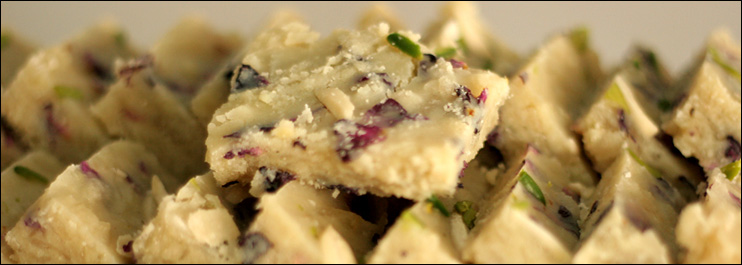 The thing I’ve always liked best about journalism is the invitation to enter someone else’s world – sometimes for a few hours sometimes for a bit longer. For a recent writing assignment I had to meet up with wedding caterers in different parts of Delhi. At perhaps the best sweetshop in the city, I was briefly introduced to a world where the quality of your clarified butter and milk solids are paramount. Indian milk-based sweets are made up of basically of these two items – everything else is optional and will do very little to improve the taste of your dessert if you skimped here.
Indian D-I-Y (December 31, 2007) I finally understood fully what the word "jugaad" meant as I watched a man labouring over my car alarm for 45 minutes. He began by tinkering with wires that I knew for a fact were part of the alarm. When that failed to yield the desired results, he spread his tinkering to a wider arena, undoing boxes on the side, whose connection with the alarm were a little sketchy to my mind. But it was when he began removing the screws from the drivers' side door in a clear attempt to take it apart, I put my foot down. This man had not fixed the car alarm -- he clearly did not know how to fix the alarm -- but he was not going to let that stop him.
I only noticed this word myself recently, though in the past two or three years commentators from the world of technology and management have tried to add it to the lexicon of business jargon, making some good points along the way. Necessity has been the mother of invention here -- for long years (and still) a place where you couldn't buy or fix things the formal way because products or parts just were not available. The recklessness comes in because in some cases, if you didn't rig up your own solution, you probably were screwed. If you look anywhere in India, particularly outside of big cities, you can see examples of jugaad both big and small. The photograph here shows how a family in a village on Havelock Island in the Andamans gets their little transistor to work even though AA batteries aren't available locally. At the hotel I stayed in before flying to the Andamans, one of the staff rigged a stand for the mosquito coil out of a matchstick and a tiny bar of soap. In villages, people attach the cut-off top thirds of soda bottles to water pumps to make it easier to fill bottles or small containers. One of the better-known examples of jugaad are these vehicles rigged up out of diesel water pump engines in rural areas -- they go by the name jugaad. Many examples of jugaad appear to originate in Punjab, a state that prides itself on the inventiveness of its people, though the following example is surely apocryphal, and if not, at least unhygienic. It is said that restaurants in the state use washing machines to make mass quantities of frothy buttermilk for their customers.
I read an article the other day about how Indians are willing participants in corruption -- creating a demand for it. I thought that seemed to imply you really have a choice. Sometimes you do. But often, when doing it by the book means never seeing an end to your case because the reason you are getting the run-around is to convince you of the foolishness of this method -- do you really have a choice? I was ruminating on this all afternoon, after RM called me today, much to my surprise. I thought that he would have noticed my flailing helplessness in the face of the system and tried to resolve his problem through other means by now. Even though I was at the root of his recent problems. About two weeks ago, a few days after one of Delhi's infamous Blueline private buses had run into a crowd of pedestrians and killed seven of them, I set off to do a story on the buses. The substitute office cleaner was sent along with me, to help me navigate the system. At one point the bus we were on took off from its stop and I suggested to my helper that we get off at the next stop. Come a red light, the bus slowed behind some authorickshaws and my cleaner pal disembarked. I followed him. And the bus was pulled over after the traffic light for making a nondesignated stop. The bus driver and conductor tried to reason with the traffic policeman, but in the wake of a bad bus accident he was no doubt under strict orders to up tickets -- at least so other bus drivers said. So the staff called me over. In retrospect, I think this made matters worse for them. While trying to speak to the policeman, he interrupted and told me that I must learn Hindi if I wished to converse with him -- this while I was attempting to speak in my most best Hindi. My language skills deteriorated entirely, but still I tried to persevere in my incoherent state. All our efforts only brought the bus driver a court ticket rather than an on-the-spot fine. When I tried to find out how much the fine might cost, the policeman threw out random numbers, "600 rupees! 20,000 rupees!" Finally he told me, "Don't go into this too deeply. This is beyond your understanding." The next day I wrote up a nice long statement on behalf of the bus driver, praising his driving skills and generally castigating myself. RM -- the owner of the bus -- was very pleased the next day when I went to meet him at the traffic court on Parliament Street, saying it was a very good statement. The conductor was a little unhappy since I had mistook his name for the bus driver's and put him in my statement instead. It didn't matter anyway, since out designated special magistrate Datta was missing-in-action that day. No reason given. The bus folks went to a bigger local court in the afternoon but all they got was another hearing date -- for today. I pitched up in the afternoon feeling nervous. I don't want to use the K-word but honestly, at this point I was feeling that the judge could suddenly declaim, "Off with their heads!" And so it would be.
At
this point, both RM and the magistrate suggested I was no longer
required there. What happened after I left? I really can't say.
I couldn't help but think of the stories people had told me, when
I said I was going to give a statement in favour of the bus driver.
You're wasting your time, one office receptionist told me, remembering
how he tried to contest a fine. He went to the traffic court over
and over. Sometimes the judge wasn't there. Sometimes he got a summons
for another date. It would have gone on for a year, he said. One
day at the traffic court, a tout told him: Later
I called RM to find out what happened after I left.
Last
day of Durga (October 21, 2007) On Sunday, October 21, which was also the festival of Dussehra -- all the idols were taken to the Yamuna to be immersed. This was rather a sorry sight I must say and seemed also a stampede-prone occasion. First of all, the statues were brought to the river banks in trucks and lorries, none of which appeared to meet any emissions standards. So the devotees who had turned up to bid farewell to Durga were swathed in a gray haze and coughing ferociously. Still, they managed to keep in good cheer, singing and dancing as the trucks unloaded their precious cargo. The next tricky part was getting the heavy statues to the water. This involved a lot of use of ropes and heavy grunting and pushing. Sometimes the goddess would gain a momentum of her own and cries of "Shoro! Shoro! (Move aside!)" pierced the air and worshippers were shoved aside rapidly as the statue would unceremoniously plunge into the dank water at a bizarre angle -- sideways or on her front -- leading to tsking from the older ladies at the breach of decorum. On
the evening of Dussehra -- which marks the day that the god-incarnate
slays the ten-headed demon Ravan -- there are pageants all across
the city re-enacting this battle. It all culminates in the burning
of a larger-than-life effigy of Ravan. All in all, a very smoky
day. |
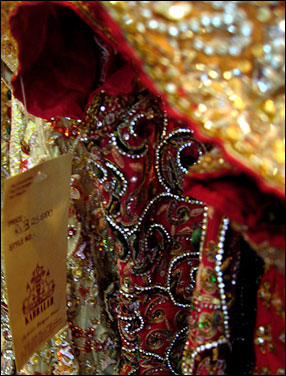 Crowds
of young and older women thronged the Frontier Bazaar, easily one
of the most popular booths at an exhibition where scores of designers
and jewelers were showing their wares ahead of the start of the
11-billion-dollar Indian wedding season.
Crowds
of young and older women thronged the Frontier Bazaar, easily one
of the most popular booths at an exhibition where scores of designers
and jewelers were showing their wares ahead of the start of the
11-billion-dollar Indian wedding season. 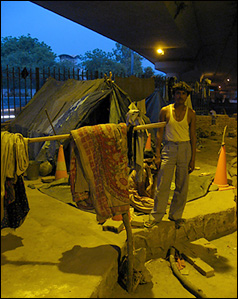 The
Good Contractor
introduced himself to me first as an ordinary worker who lived under
the flyover opposite the Oberoi Hotel.
The
Good Contractor
introduced himself to me first as an ordinary worker who lived under
the flyover opposite the Oberoi Hotel. 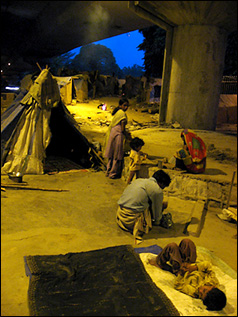 His
two stories were so interspersed that I'm still not sure which things
truly happened to him and which are the things he told me in his
guise of a construction worker.
His
two stories were so interspersed that I'm still not sure which things
truly happened to him and which are the things he told me in his
guise of a construction worker. 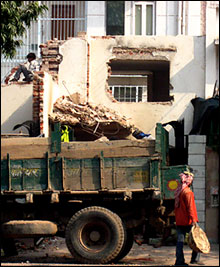 For
months I was awakened by a sharp, whining drone from the house opposite.
On investigation, it turned out to be the sound of large sheets
of marble being planed - and a lot of marble needs to be planed
to tile a four-floor house. I watched for the better part of last
year as a hole in the ground that used to be a humble concrete bungalow
with just a ground and a first floor and a little patch of garden
became a gleaming white mansion.
For
months I was awakened by a sharp, whining drone from the house opposite.
On investigation, it turned out to be the sound of large sheets
of marble being planed - and a lot of marble needs to be planed
to tile a four-floor house. I watched for the better part of last
year as a hole in the ground that used to be a humble concrete bungalow
with just a ground and a first floor and a little patch of garden
became a gleaming white mansion.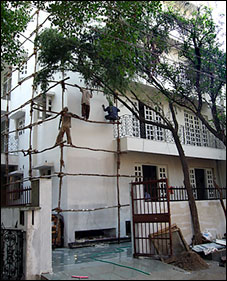 Initially
the Bihari workers who built it would live in little shacks on the
grounds - in these ways the village comes to the city -- later they
lived in the house itself but bathed with buckets of water outside
it. Perhaps they would never live in such a lavish house again or
in the midst of such a solidly upper-middle-class neighbourhood.
In a surprisingly short time their stay there came to an end. The
house's completion was marked by the sounds of a foreign voice ringing
out one evening to accept delivery of a heavy wooden desk and a
uniformed guard permanently on duty outside.
Initially
the Bihari workers who built it would live in little shacks on the
grounds - in these ways the village comes to the city -- later they
lived in the house itself but bathed with buckets of water outside
it. Perhaps they would never live in such a lavish house again or
in the midst of such a solidly upper-middle-class neighbourhood.
In a surprisingly short time their stay there came to an end. The
house's completion was marked by the sounds of a foreign voice ringing
out one evening to accept delivery of a heavy wooden desk and a
uniformed guard permanently on duty outside.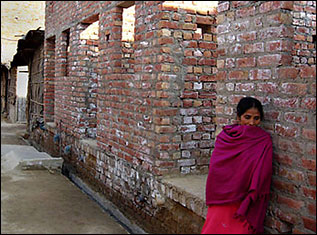
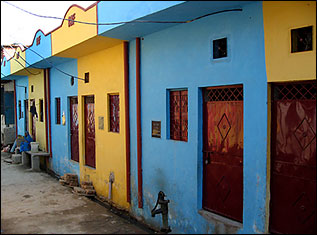
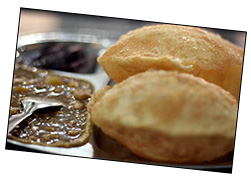
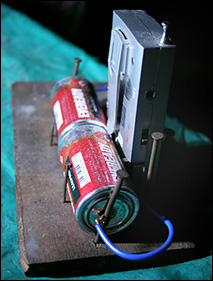 That
was the moment I realised that jugaad -- variously translated as
innovation,
That
was the moment I realised that jugaad -- variously translated as
innovation, 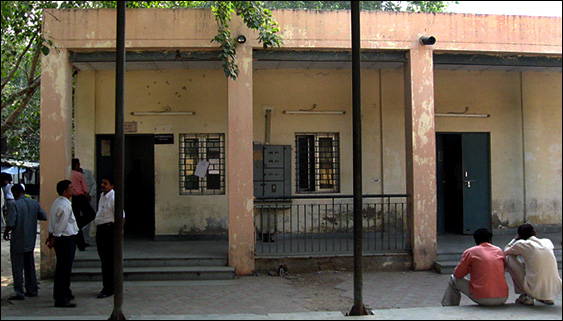 Traffic
Court (October 25, 2007)
Traffic
Court (October 25, 2007)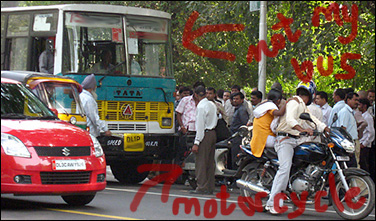 But
of course it wasn't like that. Instead magistrate Datta proceeded
to give us yet another hearing date and tell us all about the lengthy
process behind contesting a challan. First you must give the notice,
he said. Then the prosecution must be called, he said. Then witnesses.
Then...by this time, my eyes were glazing over. All this for getting
down at a red light? And what about the reckless buses that screech
past me overtaking me from the left at 100 kilometres-an-hour? You
never see them getting tickets. (The picture at the right was taken outside the traffic court.)
But
of course it wasn't like that. Instead magistrate Datta proceeded
to give us yet another hearing date and tell us all about the lengthy
process behind contesting a challan. First you must give the notice,
he said. Then the prosecution must be called, he said. Then witnesses.
Then...by this time, my eyes were glazing over. All this for getting
down at a red light? And what about the reckless buses that screech
past me overtaking me from the left at 100 kilometres-an-hour? You
never see them getting tickets. (The picture at the right was taken outside the traffic court.)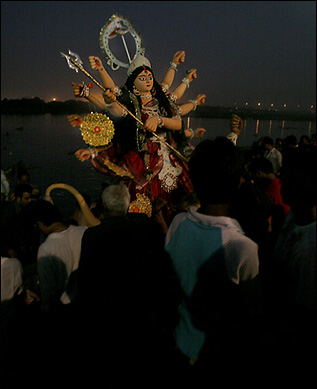 I love this time of the year for the way in which one can go careening
from one festival to another as the weather, the houses and one's
bones get progressively chillier. Last weekend was Eid and this
week was a double feature -- Durga Puja and Dussehra. All week Bengalis
went to visit tents in their neighborhoods where sculptures of Durga
-- the embodiment of female power or Shakti -- several feet high
took pride of place. But of course there was lots of eating and
drinking too.
I love this time of the year for the way in which one can go careening
from one festival to another as the weather, the houses and one's
bones get progressively chillier. Last weekend was Eid and this
week was a double feature -- Durga Puja and Dussehra. All week Bengalis
went to visit tents in their neighborhoods where sculptures of Durga
-- the embodiment of female power or Shakti -- several feet high
took pride of place. But of course there was lots of eating and
drinking too. 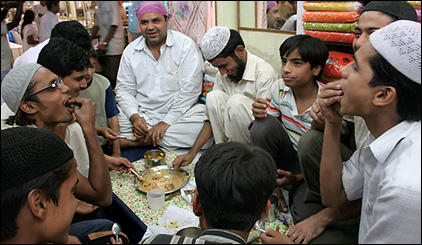 Old
Delhi Iftar (October 15, 2007)
Old
Delhi Iftar (October 15, 2007)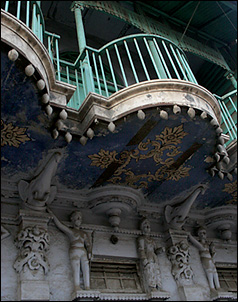 We
started at a building whose balcony I had always admired while on
cycle rickshaws heading back to the metro station. From a distance
it looked like bare-breasted nymphs were holding up a royal blue
balcony with gilt fleur-de-lis designs. Up close the nymphs were
actually Indian men, wearing dhotis and sometimes turbans. The building
now houses an office but the woman who opened the door to the balcony
for us declined to say what sort of work they did there.
We
started at a building whose balcony I had always admired while on
cycle rickshaws heading back to the metro station. From a distance
it looked like bare-breasted nymphs were holding up a royal blue
balcony with gilt fleur-de-lis designs. Up close the nymphs were
actually Indian men, wearing dhotis and sometimes turbans. The building
now houses an office but the woman who opened the door to the balcony
for us declined to say what sort of work they did there. 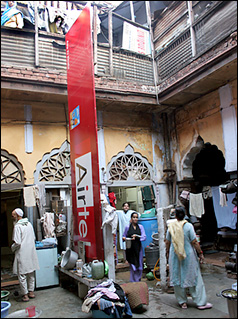 Although
the young man was initially happy about the half-hour reprieve,
he got more and more tense and nervous as we left the main road
behind and headed into allies, making pit stops here and there when
we saw an interesting looking doorway. At one lovely home, which
now had an Airtel sign in the central courtyard, we met the 98-year-old
patriarch who was born in the house. His cheery and slightly rakish
looking grandson, who led us inside, was to get married the day
after Eid to a Hindu girl he had met in school. We halted in the
alley to chat with him on the way out and suddenly a crowd seemed
to be gathering around us. The young man from the offfice we had
come from said, "The ambience is not good here. You better
get away from here."
Although
the young man was initially happy about the half-hour reprieve,
he got more and more tense and nervous as we left the main road
behind and headed into allies, making pit stops here and there when
we saw an interesting looking doorway. At one lovely home, which
now had an Airtel sign in the central courtyard, we met the 98-year-old
patriarch who was born in the house. His cheery and slightly rakish
looking grandson, who led us inside, was to get married the day
after Eid to a Hindu girl he had met in school. We halted in the
alley to chat with him on the way out and suddenly a crowd seemed
to be gathering around us. The young man from the offfice we had
come from said, "The ambience is not good here. You better
get away from here." 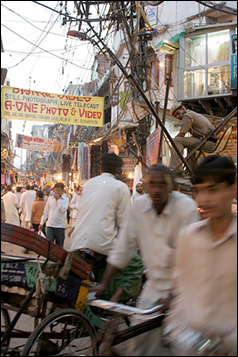 And
certainly, when we left behind the Airtel haveli we did hear a fight
flare up -- J. insists that he saw a young man come out of the alley,
grab a metal stool and dash back in, perhaps with the intent of
using it to bash someone's face in. J. was hopeful that the brouhahaha
might have been caused by his presence -- him being a foreigner
and all -- but our self-appointed guide told us a garbled story
about a man who had dashed into the road and hidden in someone's
house while the police were pursuing him. The owner of the house
took issue with the fleeing suspect choosing his home for refuge,
apparently.
And
certainly, when we left behind the Airtel haveli we did hear a fight
flare up -- J. insists that he saw a young man come out of the alley,
grab a metal stool and dash back in, perhaps with the intent of
using it to bash someone's face in. J. was hopeful that the brouhahaha
might have been caused by his presence -- him being a foreigner
and all -- but our self-appointed guide told us a garbled story
about a man who had dashed into the road and hidden in someone's
house while the police were pursuing him. The owner of the house
took issue with the fleeing suspect choosing his home for refuge,
apparently.